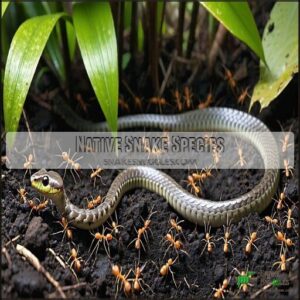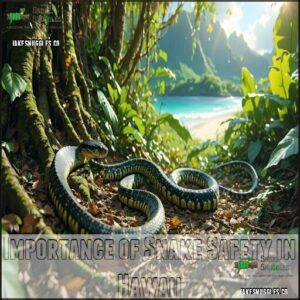This site is supported by our readers. We may earn a commission, at no cost to you, if you purchase through links.
 You won’t find native snakes in Hawaii—it’s like the islands drew a firm no-snake policy!
You won’t find native snakes in Hawaii—it’s like the islands drew a firm no-snake policy!
However, invasive species occasionally make their way in due to human activity.
The brown tree snake, for instance, can hitch rides in cargo and wreak havoc on native birds. Ball pythons, boa constrictors, and even harmless species like garter snakes have popped up too.
These uninvited guests threaten Hawaii’s fragile ecosystem, putting native species at risk.
Strict laws and vigilant monitoring help keep the islands as snake-free as possible.
Curious how conservation teams tackle this challenge? Let’s explore the fascinating efforts to protect Hawaii’s biodiversity.
Table Of Contents
- Key Takeaways
- Presence of Snakes in Hawaii
- Native Snake Species
- Invasive Snakes in Hawaii
- Threats Posed by Invasive Snakes
- Laws and Snake Control in Hawaii
- Importance of Snake Safety in Hawaii
- Conservationists’ Efforts in Protecting Hawaii’s Biodiversity
- Frequently Asked Questions (FAQs)
- What snakes live in Hawaii?
- Are blind snakes native to Hawaii?
- Are there snakes in Maui?
- Why are there no snakes in Hawaii?
- Are there snakes in the Aloha State?
- Are there poisonous snakes in Hawaii?
- Are there any poisonous snakes in Hawaii?
- Does Hawaii have big snakes?
- Is there a snake problem in Hawaii?
- Why is Hawaii snake free?
- Conclusion
Key Takeaways
- Hawaii doesn’t have native snakes, but the Brahminy blind snake, a tiny and harmless species, lives there and helps control pests.
- Invasive snakes like brown tree snakes, ball pythons, and boa constrictors occasionally arrive through cargo or illegal pet ownership and threaten Hawaii’s fragile ecosystem.
- Strict laws, such as hefty fines and jail time, are in place to prevent the import or possession of snakes and protect the islands’ biodiversity.
- If you spot a snake, report it immediately to help conservation efforts and prevent ecological damage.
Presence of Snakes in Hawaii
Are there snakes in Hawaii? Surprisingly, yes—but only due to accidental imports or illegal pet ownership.
Hawaii’s unique island ecosystem has no native snakes, earning it a nearly snake-free status.
Hawaii stands apart with its rare, nearly snake-free paradise, preserving its fragile island ecosystem.
Unfortunately, invasive snakes sometimes sneak in as stowaways via cargo shipments, threatening the fragile environment.
For instance, yellow-bellied sea snakes occasionally drift into coastal waters.
Quick action is critical regarding snake sightings in Hawaii, as these introductions can disrupt the careful balance of nature.
The good news? Strict laws and dedicated monitoring keep the risk low.
Reporting sightings helps protect Hawaii’s biodiversity from harmful invasive snakes.
The state also runs a snake amnesty program to encourage the surrender of illegal pets.
Native Snake Species
Contrary to popular belief, Hawaii isn’t entirely snake-free. While there are no native snakes, a small non-native species, the Brahminy blind snake, calls these islands home.
Often mistaken for an earthworm, this tiny snake plays an unexpected role in pest control. Introduced around the 1930s, it thrives in moist soil and garden beds, feeding on ants and termites.
- Non-venomous and under 7 inches long.
- Prefers habitats like leaf litter and soft soil.
- Acts as natural pest control for insects.
- Highlights challenges in protecting Hawaii ecosystems.
Invasive Snakes in Hawaii
You’ll find that invasive snakes in Hawaii pose serious risks to the islands’ delicate ecosystems.
These non-native species, like the brown tree snake and ball python, can upset the natural balance by preying on local wildlife and outcompeting native species for resources.
Brown Tree Snake (Boiga Irregularis)
The Brown Tree Snake (Boiga irregularis) is an infamous predator that could turn Hawaii’s delicate ecosystem upside down.
Native to the South Pacific, this invasive species preys on birds, lizards, and small mammals, posing a threat to island biodiversity.
Without natural predators, it thrives unchecked, leading to bird predation and ecological imbalance.
It’s already devastated Guam’s ecosystem and could do the same in Hawaii.
These snakes often arrive as cargo stowaways, making constant monitoring paramount.
Their mild venom isn’t harmful to humans but can disrupt ecosystems.
Reporting sightings promptly is key to containing these invasive snakes.
Control measures and eradication efforts protect Hawaii from the severe snake threats they present.
Ball Python
Ball pythons, often associated with Ball Python Morphs, are nonvenomous and can grow up to six feet long, posing ecological risks if released into Hawaii’s ecosystem.
Their Ball Python Diet includes small mammals and birds, potentially disrupting native species that lack natural defenses.
Popular as exotic pets, Captive Ball Pythons are prohibited in Hawaii due to their Python Introduction Risk from accidental escapes.
These snakes, adaptable and hardy, could thrive in various habitats, causing severe damage.
Strict laws against illegal snakes Hawaii aim to prevent such incidents.
Promptly report any snake sightings Hawaii to protect native biodiversity and ecosystems.
Boa Constrictor
Boa constrictors are one of the most dangerous invasive snakes in Hawaii.
These predators can grow over 10 feet long, thrive in dense vegetation, and target small mammals and native birds.
Their presence threatens Hawaii’s delicate ecosystem by disrupting the food chain.
Here’s why boa constrictors are a serious concern:
- Boa Habitat: They adapt easily to Hawaii’s forests, favoring thick vegetation.
- Boa Diet: Birds and small mammals are their primary prey.
- Boa Breeding: Females produce large litters, leading to rapid population growth.
- Boa Impact: They outcompete native predators, causing ecological imbalance.
Garter Snake
Garter snakes, though harmless to humans, bring trouble to Hawaii’s delicate ecosystems.
These adaptable creatures find their way into shipments, like Christmas trees, and impact native wildlife with their diverse diet.
Known for preferring habitats like gardens or grasslands, they pursue small animals, disrupting the food chain.
Early sightings matter, as garter snakes—resembling harmless earthworms at a glance—can spread unchecked without action.
The checkered garter snake, for example, requires tall vegetation for hunting.
- Picture this: slender bodies weaving through lush Hawaiian landscapes, stirring up ecological imbalance.
Corn Snake
Corn snakes, a striking yet invasive snake species in Hawaii, spell trouble for the islands’ biodiversity. Their adaptability and rapid reproduction make them a serious ecosystem threat. Growing concerns around captivity add to the issue, as escaped pets often lead to wild populations.
- Ecosystem disruption through their diverse diets.
- Hybridization risks with other invasive snakes.
- Escape from captivity worsens their spread.
- Eradication efforts drain resources.
These snakes, although beautiful, highlight the importance of strict snake controls in protecting Hawaii’s fragile environment.
Threats Posed by Invasive Snakes
Invasive snakes can wreak havoc on Hawaii’s delicate ecosystems by preying on native species and competing for resources.
Without natural predators, their unchecked growth threatens biodiversity and disrupts the balance of the environment.
Impact on Ecosystem
Invasive snakes in Hawaii bring more than just a curiosity—they disrupt the ecosystem in ways that ripple through the environment.
Invasive snakes threaten Hawaii’s delicate ecosystem, creating ripples of disruption that endanger native species and biodiversity.
Native birds, especially endangered species, face steep declines as their eggs and chicks become easy prey. This predation causes biodiversity loss, leaving holes in the food web that can’t easily be filled.
These disruptions don’t stop there. Hawaii snakes also compete with native species for limited resources like food and shelter, leading to habitat modification.
Even insects, fundamental to the balance, either overpopulate or vanish, further destabilizing the ecosystem.
Invasive species like snakes aren’t just a nuisance; they’re a game-changer, threatening the unique balance that Hawaii’s wildlife and plants have relied on for centuries.
Vulnerability of Native Species
Hawaii’s delicate ecosystems often can’t handle invasive snakes.
With invasive snakes like Brahminy blind snakes, native species face drastic challenges. Birds, for example, experience population declines, bringing extinction risks closer.
Ecosystem disruption impacts the food chain, while small animals and insects struggle to survive with new predators. Habitat loss worsens everything, leaving native life with fewer safe zones.
Protecting Hawaii ecosystems requires constant attention to snake threats Hawaii faces.
- Key threats: Bird population decline, habitat loss, and extinction risks.
- Impacts: Disrupted food chains, biodiversity loss, and displaced species.
- Why it matters: Native populations have no natural defenses.
- Solutions: Better effort to stop invasive snakes Hawaii and appreciate what it protects.
Ecological Disasters
While native species lack natural defenses against predators, the ecological disasters caused by invasive snakes can completely transform Hawaii’s environment.
The brown tree snake demonstrates this danger perfectly.
In Guam, it eliminated 10 of 12 native bird species, creating extinction events that unraveled the entire food web.
Without natural predators in Hawaii, invasive snakes would devastate bird populations, disrupt pollination, and trigger habitat loss. They can even become disease vectors affecting multiple species.
This threat extends beyond wildlife—when genetic diversity collapses, the entire ecosystem becomes vulnerable to complete collapse, forever changing Hawaii’s natural heritage.
Economic Costs
Ever wondered just how much damage invasive snakes cost Hawaii? The economic burden is staggering, with estimates ranging from $593 million to $2.14 billion annually if brown tree snakes become established.
These introduced snake species threaten more than just wildlife. They’ve caused power outages costing $4.5 million per year in Guam—a preview of potential infrastructure damage in Hawaii.
Tourism impact is significant too, as visitors seeking a snake-free paradise might choose alternative destinations.
Agricultural losses could reach half the value of Hawaii’s crop production, while property values typically decline in areas with invasive species infestations.
Snake control Hawaii programs require substantial investment, with current prevention efforts costing hundreds of thousands annually.
Healthcare costs for potential snakebites add to the burden, though rarely calculated. The economic multiplier effect means every dollar lost generates $1.82 in additional losses throughout Hawaii’s economy.
Eradication expenses aren’t just about removing Hawaii snakes—they’re investments in protecting the islands’ economic future.
Laws and Snake Control in Hawaii
You’ll face severe penalties in Hawaii if you import or possess snakes, including fines up to $200,000 or three years imprisonment.
Hawaii’s strict snake control laws protect its fragile ecosystem from invasive species that could devastate native wildlife populations.
Strict Regulations
While invasive snakes devastate ecosystems, Hawaii fights back with iron-clad legal barriers.
Owning a snake in paradise can cost you dearly—up to $200,000 in fines or three years behind bars. The state’s importation penalties aren’t just for show; they’re actively enforced to protect delicate island biodiversity.
- No exceptions exist—pet snake permits simply aren’t available
- Legal consequences include possible felony charges
- Amnesty programs allow snake surrender without punishment
- Public reporting through the 643-PEST hotline helps enforcement
Despite these strict snake laws and government regulations, smugglers occasionally succeed—making every citizen’s vigilance paramount.
Monitoring at Ports of Entry
Building on Hawaii’s strict regulations, vigilant monitoring at entry points forms your next line of defense against invasive snakes.
At airports and harbors across the islands, specialized teams conduct thorough cargo inspections, examining thousands of containers daily.
Highly trained detector dogs sniff out potential stowaways, detecting scents that human inspectors might miss.
When suspicious items appear, quarantine protocols immediately isolate shipments until they’re confirmed snake-free.
Border security officers utilize advanced surveillance systems to screen for snake smuggling attempts. To aid in this effort, one can explore specialized snake tools for improved detection.
The Department of Homeland Security processes over 10,500 shipments daily through port inspections, with stowaway prevention as a top priority.
Their efforts specifically target brown tree snakes from Guam, which have previously arrived hidden in cargo.
To support snake detection efforts, report any sightings immediately to 643-PEST.
Educational Initiatives
Beyond monitoring ports, education forms Hawaii’s frontline defense against invasive snakes.
Educational initiatives across the islands combine public awareness campaigns with practical training. You’ll find resources designed for everyone from schoolchildren to wildlife enthusiasts.
When you participate in Hawaii’s snake education programs, you’ll:
- Learn to identify different snake species through interactive workshops
- Practice using the snake reporting system with guidance from conservation experts
- Explore realistic scenarios through community outreach events that simulate snake encounters
Teacher training programs equip educators with curriculum materials that make snake awareness engaging for students. These programs emphasize the importance of early reporting and proper species identification. To further protect the islands, the state employs strict importation regulations.
Community outreach events bring snake education directly to neighborhoods, ensuring everyone understands their role in protecting Hawaii’s unique ecosystem from snake invasions.
Pest Management Practices
Today, Hawaii employs multiple pest management strategies to combat invasive snake species.
At ports of entry, trained canine detection teams intercept potential snake stowaways, while quarantine protocols make certain of thorough inspection of incoming cargo.
When snakes are spotted, officials use specialized trapping techniques including hand capture and barriers with chemical repellents.
The state’s successful amnesty program allows residents to surrender illegal pet snakes without penalties, preventing future escapes into the wild.
Public reporting systems, like the 643-PEST hotline, enable quick response to snake sightings. Officials also utilize targeted fumigation in high-risk areas and implement containment measures for established populations.
Some residents also seek Hawaii snake repellents to protect their properties.
These snake control efforts represent an annual investment against potential damages that could otherwise reach $1.7 billion if invasive species like the brown tree snake established themselves throughout Hawaii.
Conservation Efforts
Hawaii’s conservation efforts focus on protecting its delicate ecosystem through a mix of science and public participation.
Strict measures target invasive species and maintain biodiversity, guaranteeing Hawaii’s wildlife thrives.
Here’s how conservation works:
- Habitat Restoration: Rebuilding natural areas gives native species a safe place to flourish.
- Species Management: Preventing harmful invaders like the brown tree snake safeguards vulnerable animals.
- Public Awareness: Educational programs empower people to report illegal pets or snake sightings.
- Quarantine Measures: Monitoring arrivals via ports and cargo prevents stowaways.
Over 100 snakes have been confiscated since 2000, thanks to monitoring programs and amnesty initiatives.
Effective snake conservation guarantees Hawaii’s natural balance remains intact for generations to enjoy its beauty and biodiversity.
Importance of Snake Safety in Hawaii
You play a key role in keeping Hawaii’s ecosystem safe by understanding the importance of snake safety.
Reporting sightings and following safety guidelines can help protect native species and minimize risks to humans.
Preservation of Ecosystem
To protect Hawaii’s fragile ecosystem, invasive snakes must be controlled.
These species threaten the delicate balance of native plants and animals, disrupting biodiversity protection efforts.
Without invasive control and habitat restoration, Hawaii’s unique wildlife and coral reefs could face irreversible harm.
Active species management and public awareness are key in preserving this interconnected web of life.
Every effort, from reporting sightings to supporting conservation projects, matters.
It’s not just scientists safeguarding Hawaii’s stunning environment—it’s up to all of us to prioritize wildlife conservation for future generations. Invasive snakes
Identifying and Reporting Sightings
Spotting a snake in Hawaii? Act fast but smart. Accurate reporting helps protect the islands’ delicate ecosystem. First, observe from a safe distance—don’t get too close. Use your phone’s zoom to take a clear photo.
Follow these steps:
- Identify key features: Note the snake’s size, color, patterns, and movements.
- Capture evidence: Use digital photography to document safely.
- Report immediately: Call 911 or the snake hotline Hawaii (808-643-PEST).
- Provide details: Share location, environment, and time of sighting.
- Avoid direct interaction: Don’t attempt to capture or handle it.
By following these reporting procedures, your efforts support public cooperation and effective snake identification Hawaii depends on.
You may also find related product offerings online.
Wildlife Respect
Respect Hawaii’s wildlife by treating it as you’d a delicate piece of art—look, but don’t touch.
Snakes like the Brahminy Blind Snake may seem harmless, but disrupting their habitats can ripple through the fragile ecosystem.
Supporting laws like Hawaii’s snake ban makes certain balance stays intact.
Follow these simple rules for wildlife respect:
- Observe Wildlife: Watch from a distance—your curiosity shouldn’t stress animals.
- Protect Habitats: Stay on trails to avoid trampling sensitive vegetation.
- Report Sightings: Notify authorities about non-native snake species in Hawaii.
Your mindful actions, like leashing pets or avoiding feeding animals, help conserve nature.
Minimizing Harm to Humans
Regarding snake safety, a little preparation can help you avoid unnecessary risks.
If you spot a snake, stay calm and step back—don’t handle it. Most snakes in Hawaii are invasive, and some, like the yellow-bellied sea snake, are venomous. Call local authorities immediately to report sightings.
Hiking precautions are key: stick to clear trails, wear sturdy shoes, and keep pets close.
For pet safety, remember owning snakes is both illegal and harmful to Hawaii’s ecosystem.
Around water, practice ocean safety by steering clear of densely vegetated shores.
Snake bite prevention starts with education. Learn to identify harmful species, share what you know, and prepare for emergencies by knowing where medical help is available.
Snake education and awareness are your strongest tools in reducing snake dangers and staying safe.
Conservationists’ Efforts in Protecting Hawaii’s Biodiversity
Conservationists in Hawaii work tirelessly to preserve its biodiversity, addressing invasive species that threaten delicate ecosystems.
Smart species management strategies, such as targeting the invasive Brown Tree Snake, help limit its impact on native birds and other wildlife. These efforts are part of larger initiatives to protect habitats from snake impact and Hawaii’s unique environment thrives.
Public awareness campaigns play a key role, teaching residents and visitors how to identify and report invasive species. By staying informed, you can become a key partner in snake prevention Hawaii.
The Hawaii Department of Agriculture reinforces these actions by monitoring ports of entry, enforcing laws, and supporting wildlife conservation. To address the issue, Hawaii has a strict snake policy to prevent new introductions.
Additionally, habitat restoration projects aim to rebuild natural ecosystems, giving endangered plants and animals a safe refuge.
Through ecosystem research, conservationists develop effective methods for snake eradication Hawaii, keeping invasive species under control and protecting Hawaii’s fragile balance.
Frequently Asked Questions (FAQs)
What snakes live in Hawaii?
Hawaii hosts the tiny Brahminy blind snake, often mistaken for an earthworm.
Additionally, invasive species like ball pythons, boa constrictors, and rare sea snakes occasionally appear but aren’t native, posing risks to the fragile ecosystem.
Are blind snakes native to Hawaii?
About 30% of snake species are blind, but Brahminy Blind Snakes aren’t native to Hawaii.
They likely hitchhiked in potted soil.
Cute yet worm-like, they’re harmless but can still disrupt local ecosystems. They’re harmless but can still disrupt local ecosystems.
Are there snakes in Maui?
You won’t find native snakes in Maui, but Brahminy blind snakes, tiny and harmless, can appear in gardens or potting soil.
Occasionally, non-native species show up, so report sightings to protect Hawaii’s ecosystem.
Why are there no snakes in Hawaii?
Hawaii’s isolation as a volcanic island naturally kept snakes from colonizing.
Strict laws and active monitoring prevent their introduction, protecting native ecosystems.
Without natural predators, invasive snakes could quickly disrupt Hawaii’s fragile biodiversity and balance.
Are there snakes in the Aloha State?
You’d be surprised, but while snakes aren’t native to Hawaii, a few non-native species like the Brahminy blind snake and occasional sea snakes pop up.
Strict laws help protect the islands from invasive snake threats.
Are there poisonous snakes in Hawaii?
You won’t find poisonous snakes in Hawaii, but a few venomous ones, like yellow-bellied sea snakes, may occasionally drift into the area.
They rarely pose a threat since they almost never come ashore.
Are there any poisonous snakes in Hawaii?
You won’t encounter any poisonous snakes in Hawaii naturally.
The island’s only resident snake, the Brahminy blind snake, is harmless.
However, occasional venomous sea snakes, like the yellow-bellied sea snake, might drift into Hawaiian waters.
Does Hawaii have big snakes?
Hawaii doesn’t have big snakes naturally due to strict regulations, but illegal imports like boa constrictors or ball pythons occasionally show up.
These large snakes can disrupt ecosystems, so sightings should be reported immediately.
Is there a snake problem in Hawaii?
Around 99% of Hawaii remains snake-free, but invasive species like brown tree snakes and boa constrictors pose risks.
Strict laws and active monitoring help protect ecosystems, though occasional sightings keep authorities on high alert.
Why is Hawaii snake free?
Strict laws, geographic isolation, and proactive monitoring keep Hawaii snake-free.
Snakes can’t survive without introduction, and strict import bans prevent this.
Unique biodiversity thrives while habitats stay safe from predators, maintaining Hawaii’s near-perfect balance.
Conclusion
Hawaii’s unique policy on native snakes helps preserve its fragile ecosystem, but invasive species occasionally sneak in.
These unexpected guests, like the brown tree snake or ball python, can disrupt native wildlife and cause ecological damage.
Strict laws, vigilant monitoring, and public awareness are key to minimizing risks.
By respecting Hawaii’s biodiversity and reporting any sightings, you play a fundamental role in keeping these islands snake-free.
Protecting Hawaii means balancing vigilance with a love for nature’s harmony.
- https://www.nationalgeographic.com/animals/article/120914-virgin-birth-parthenogenesis-snakes-science-biology-letters
- https://www.hawaiinewsnow.com/2018/12/10/hawaii-just-purposely-imported-brown-tree-snakes-heres-why/
- https://hdoa.hawaii.gov/blog/main/nr20-10snakefoundinhilo/
- http://bigislandnow.com/2019/02/04/live-corn-snake-found-in-waipahu/
- https://www.staradvertiser.com/2018/06/05/breaking-news/ball-python-snake-found-in-hilo-heading-to-honolulu/




















